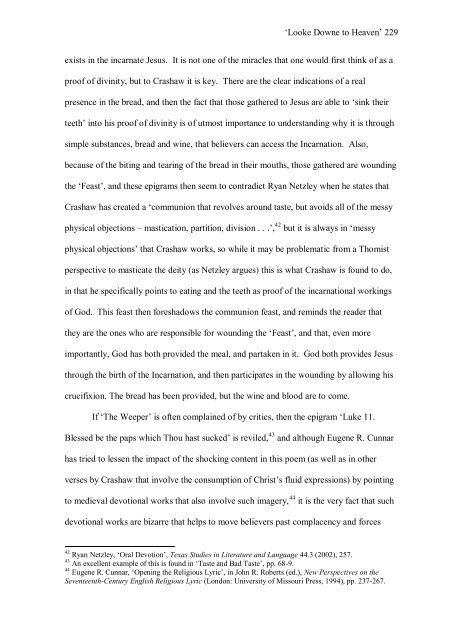Jesse Sharpe PhD thesis - Research@StAndrews:FullText ...
Jesse Sharpe PhD thesis - Research@StAndrews:FullText ...
Jesse Sharpe PhD thesis - Research@StAndrews:FullText ...
You also want an ePaper? Increase the reach of your titles
YUMPU automatically turns print PDFs into web optimized ePapers that Google loves.
‘Looke Downe to Heaven’ 229<br />
exists in the incarnate Jesus. It is not one of the miracles that one would first think of as a<br />
proof of divinity, but to Crashaw it is key. There are the clear indications of a real<br />
presence in the bread, and then the fact that those gathered to Jesus are able to ‘sink their<br />
teeth’ into his proof of divinity is of utmost importance to understanding why it is through<br />
simple substances, bread and wine, that believers can access the Incarnation. Also,<br />
because of the biting and tearing of the bread in their mouths, those gathered are wounding<br />
the ‘Feast’, and these epigrams then seem to contradict Ryan Netzley when he states that<br />
Crashaw has created a ‘communion that revolves around taste, but avoids all of the messy<br />
physical objections – mastication, partition, division . . .’, 42 but it is always in ‘messy<br />
physical objections’ that Crashaw works, so while it may be problematic from a Thomist<br />
perspective to masticate the deity (as Netzley argues) this is what Crashaw is found to do,<br />
in that he specifically points to eating and the teeth as proof of the incarnational workings<br />
of God. This feast then foreshadows the communion feast, and reminds the reader that<br />
they are the ones who are responsible for wounding the ‘Feast’, and that, even more<br />
importantly, God has both provided the meal, and partaken in it. God both provides Jesus<br />
through the birth of the Incarnation, and then participates in the wounding by allowing his<br />
crucifixion. The bread has been provided, but the wine and blood are to come.<br />
If ‘The Weeper’ is often complained of by critics, then the epigram ‘Luke 11.<br />
Blessed be the paps which Thou hast sucked’ is reviled, 43 and although Eugene R. Cunnar<br />
has tried to lessen the impact of the shocking content in this poem (as well as in other<br />
verses by Crashaw that involve the consumption of Christ’s fluid expressions) by pointing<br />
to medieval devotional works that also involve such imagery, 44 it is the very fact that such<br />
devotional works are bizarre that helps to move believers past complacency and forces<br />
42 Ryan Netzley, ‘Oral Devotion’, Texas Studies in Literature and Language 44.3 (2002), 257.<br />
43 An excellent example of this is found in ‘Taste and Bad Taste’, pp. 68-9.<br />
44 Eugene R. Cunnar, ‘Opening the Religious Lyric’, in John R. Roberts (ed.), New Perspectives on the<br />
Seventeenth-Century English Religious Lyric (London: University of Missouri Press, 1994), pp. 237-267.
















